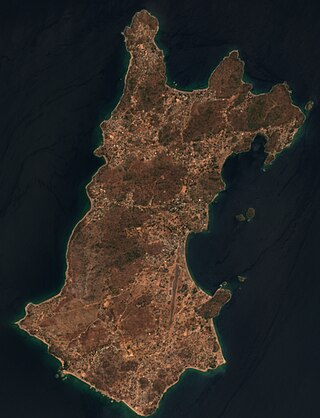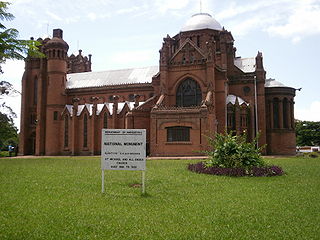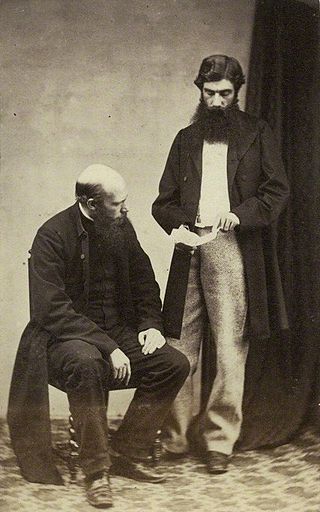
Likoma Island is the larger of two islands in Lake Malawi, in East Africa, the smaller being the nearby Chizumulu. Likoma and Chizumulu both belong to Malawi, and together they make up the Likoma District. Although both islands lie just a few kilometres from Mozambique, and are entirely surrounded by Mozambican territorial waters, they are both exclaves of Malawi.
Yohanna Barnaba Abdallah was a clergyman and historian of the Yao people of central Africa.
Charles Frederick Frazier Mackenzie (1825–62) was a Church of England Bishop of Central Africa. He is commemorated in some Anglican Church calendars.

Likoma is the main town on Likoma Island in Malawi. It is the administrative capital of Likoma District.
The Anglican Church of Tanzania is a province of the Anglican Communion based in Dodoma. It consists of 28 dioceses headed by their respective bishops. It seceded from the Province of East Africa in 1970, which it shared with Kenya. The current primate and archbishop is Maimbo Mndolwa, enthroned on 20 May 2018.
The Church of the Province of Central Africa is part of the Anglican Communion, and includes 15 dioceses in Botswana, Malawi, Zambia and Zimbabwe. The Primate of the Church is the Archbishop of Central Africa. Albert Chama is the current archbishop, being installed on 20 March 2011, succeeding Bernard Amos Malango who retired in 2007. From 1980 to 2000, Walter Khotso Makhulu, a noted Anti-Apartheid activist, was Archbishop as well as Bishop of Botswana. Archbishop Chama continues to serve as Bishop of Northern Zambia, and is the second Zambian to be Archbishop of Central Africa.

Frank Weston (1871–1924) was the Anglican Bishop of Zanzibar from 1907 until his death 16 years later.

Gerard Trower was an Anglican bishop.
John Edward Hine was an Anglican bishop in the late 19th and early 20th centuries.

MV Chauncy Maples is a motor ship and former steamship that was launched in 1901 as SS Chauncy Maples. She spent her entire career on Lake Malawi and was regarded as the oldest ship afloat in Africa. After more than one hundred years' service it was intended to restore her for use as a floating medical clinic to support the several million lakeshore dwellers whose average life expectancy is 44 years. The Government of Malawi offered support for this in 2009 and charity fundraising was sufficient to make progress. The hull was found to be beyond repair at a viable cost so a more practical modern craft was proposed to give ambulance service around the lake.

Chauncy Maples was a British clergyman and Anglican missionary who became Bishop of Likoma, with a diocese in East Africa.
The Bishop of Zanzibar is the Diocesan of an island diocese in the Anglican Church of Tanzania. Its current bishop is Michael Hafidh. The bishop's seat is Christ Church, Zanzibar, the Anglican cathedral in Stone Town, Zanzibar, Tanzania.

William Percival Johnson was an Anglican missionary to Nyasaland. After education at Bedford School (1863–1873) and graduation from University College, Oxford, he went to Africa with the Universities' Mission to Central Africa, under the Bishop Edward Steere.

According to the 2018 census, 77.3% of the population is Christian. Denominations include Roman Catholics at 17.2% of the total population, Central Africa Presbyterians at 14.2%, Seventh-day Adventist at 9.4%, Anglicans at 2.3%, Pentecostals at 7.6% and other denominations at 26.6%.

Horace Waller (1833–1896) was an English anti-slavery activist, missionary and clergyman. He was known as a writer on Africa, evangelical Christian, close associate of David Livingstone and others involved in central and east African mission and exploration work, and advocate of British imperial expansion.
John Acland Ramadhani is a former Tanzanian Anglican archbishop.
Annie Allen was a Christian medical missionary from England. She worked in Zanzibar in the 1870s and 1880s.
Events of 2020 in Tanzania.

Augustino Steven Lawrence Ramadhani was a Tanzanian jurist and Christian leader. He was Chief Justice of Tanzania from 2007 to 2010, and a Judge of the African Court on Human and Peoples' Rights from 2010 to 2016. From 2017 to 2018 he was episcopal vicar of the Diocese of Dar es Salaam.

Cecil Majaliwa was a former slave from Zanzibar who became the first African to be ordained as a priest in what is now Tanzania. After being freed, he was educated in Zanzibar and England by the Universities' Mission to Central Africa. He was highly successful during eleven years as an Anglican missionary in the south of the country. However, the European leaders of the mission downplayed his achievements and failed to promote him.











